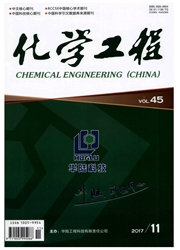

 中文摘要:
中文摘要:
乙醛一环己烷反应萃取体系能够有效分离发酵液中的2,3-丁二醇。文章重点研究了2,3-丁二醇一乙醛反应萃取液的连续水解精馏工艺,为工业化生产提供理论基础。水解精馏使用阳离子交换树脂HZ732为水解催化剂,以2,4,5-三甲基.1,3-二氧戊环(2,3-丁二醇.乙醛缩醛)水解率为指标,考察了反应段温度、反应段级数、进料速度、进料油水比(2,4,5-三甲基-1,3-二氧戊环和水摩尔比)和回流比的影响。通过实验得到优化水解精馏工艺条件为:反应段平均温度90℃,反应段理论板数为20,进料油水比为0.6,进料速度0.2h-1。在该条件下2,4,5-三甲基-1,3·二氧戊环水解率为73%,未水解2,4,5-三甲基-1,3-二氧戊环被回收。水解液经精馏得到2,3-丁二醇产品,纯度(质量分数)〉96%,总收率t〉93%。开发了连续水解精馏工艺,为整个工艺工业化实践提供了参考。
 英文摘要:
英文摘要:
Acetaldehyde-cyclohexane reactive extraction system can effectively separate 2, 3-butanediol from fermentation broth. The continuous hydrolyzing process of reactive-extraction liquid was studied. Cationic ion- exchange resin HZ732 was used as catalyst. The hydrolysis rate of 2,4,5-trimethyl-1,3-dioxolane (2,3-butanediol- acetaldehyde-acetal) was used as index. The operation conditions were investigated, which include reaction temperature, reaction stage number, feeding velocity, feed mole ratio of 2,4,5-trimethyl-1,3-dioxolane to water and reflux ratio. The appropriate operation conditions obtained are as follows : reaction temperature is 90 ~C, reaction stages are 20, mole ratio of 2,4,5-trimethyl-1,3-dioxolane to water is 0.6, and feed velocity is 0.2 h - ~. Under above conditions, more than 73% of 2,4,5-trimethyl-1,3-dioxolane can be hydrolyzed to form 2,3-butanediol. Finally, distillation was used to purify 2,3-butanediol and recover the unhydrolyzed 2,4,5-trimethyl-1,3-dioxolane. The overall yield of 2,3-butanediol can be I〉93% with purity (mass fraction) of more than 96%. The continuous hydrolyzing process can improve the hydrolysis rate of 2,4,5-trimethyl -1,3-dioxolane and can be used for industrial application.
 同期刊论文项目
同期刊论文项目
 同项目期刊论文
同项目期刊论文
 Separation of 2,3-Butanediol from Fermentation Broth by Reactive-extraction usingAcetaldehyde-cycloh
Separation of 2,3-Butanediol from Fermentation Broth by Reactive-extraction usingAcetaldehyde-cycloh 期刊信息
期刊信息
